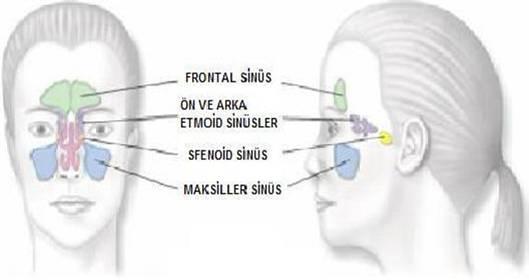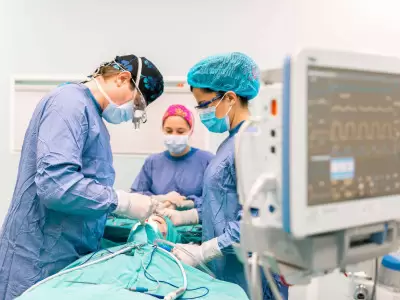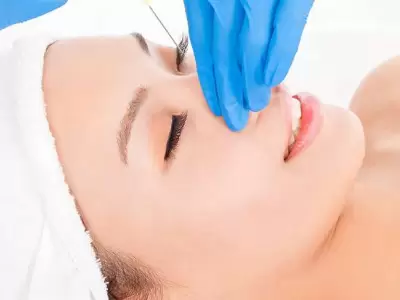Sinus Infections
What is Sinus?
The air holes that are located in the bones around the nose are called sinuses (paranasal sinus). Four pairs of sinuses are present as cheek sinuses (maxillary sinuses), frontal sinuses, sinuses between the eyes (ethmoid sinuses) and intracranial sinuses (sphenoid sinuses) (Figure 1). The mucosa lining the nose also lines the sinuses and the secretory glands of the mucosa of sinuses produce 0.5-1 liters of mucus per day. This produced mucus transferred to the narrow channels of the sinuses called ostium with the movement of microscopic cilias and emptied to the nose. Mucus helps in the defense system of the body against microbes with the substances it contains and also plays a role in the filtering of the particles in the inhaled breath and humidification of the air before going into the lungs.

Figure 1. Sinuses around the nose
What is Sinusitis – Rhinosinusitis?
All type of inflammations of the lining (mucosa) of the sinuses around the nose are called “sinusitis”.
Secretion of sinus mucosa (mucus) is actively transferred to the nasal cavity via sinus drainage canals (ostium). Obstruction of this mucus drainage canals (ostium) or the disruption of the active mucus transfer system (mucociliary activity) results in accumulation of mucus (in the sinuses) and eventually sinusitis.
Since the mucosa of the nose and the sinuses show continuousness embryological and anatomically and since they show similar response to medical and surgical treatment, the term “rhinosinusitis” is frequently preferred instead of the term “sinusitis”.
Rhinosinusitis are divided into 4 groups according to their duration and the complaints that they cause.
- Acute rhinosinusitis, are rhinosinusitis that start suddenly and result in complete disappearance within 4 weeks.
- Sub acute rhinosinusitis, are acute rhinosinusitis that last for more than four weeks and end before 12 weeks.
- Recurrent acute rhinosinusitis , is the case of having four or more acute rhinosinusitis in a year, that end in at least 7 days
- Chronic rhinosinusitis , are rhinosinusitis in which the complaints and findings last for more than 12 weeks. Acute rhinosinusitis attacks may also be present.
Reasons of Rhinosinusitis
Rhinosinusitis occur with the interaction of the patient and environmental factors. The most frequent causative reason in all groups are viral upper respiratory tract infections. Viscous mucus production of the nasal mucosa that obstructs the sinuses with edema and inflammation result in the propagation of secondary bacterial proliferation.
Mucosal edema that blocks the sinus ostiums due to allergy is the second most important reasons of rhinosinusitis. Anatomical pathologies like intranasal curvatures (septum deviations), polyps, concha hypertrophies that block the sinus drainage canals may also lead to rhinosinusitis. Cystic fibrosis disease or ciliary movement disorders that disrupt the production or transport of mucus are rarely observed. At the same time, HIV infection, chemotherapies, usage of immunsupressives, diabetes related to insulin and some collagen tissue diseases affect the immune system and may lead to rhinosinusitis.
How to Diagnose Rhinosinusitis?
In rhinosinusitis , the complaints and findings that are detected during the history and examination having importance in the diagnosis are divided into two as major complaints and findings having the first degree diagnostic value (feeling of pain and pressure in the face, swelling and fullness in the face, nasal congestion, inflammatory discharge coming from the nose-nasal cavity, not being able to smell (hyposmia) and fever) and minor complaints and findings having a diagnostic value with one or more major symptoms (headache, foul breath, weakness, coughing, earache). Since the amount of infectious secretions and edema increase in paranasal sinuses when lying down, complaints occur more at nights and in the early mornings.
Chronic rhinosinusitis only yield mild symptoms and diagnosis is difficult with only history. In general, the most meaningful complaints are discharge to the back of the nose, and the nasal cavity, headaches and sinus tenderness are the most meaningful complaints. In people with allergic rhinitis, mild complaints and examination findings should lead to the consideration of the allergy first.
In patients who are considered to have sinusitis, in addition to the general ear, nose and throat and head-neck examination in the physical examination, especially the swellings, rednesses and edema of the face (especially around the eyes), lymph node enlargements and inflammatory discharge to the back of the nose should be investigated carefully.
In the examination of the nose; edema and redness in the mucosa, inflammatory rind formations, inflammatory discharge, polyps or anatomical disorders that result in obstruction in the region that the sinus canals open to the nose (middle meatus) may be observed.
Inflammatory discharge observed in the examination of the back of the nose (nasopharynx examination) is especially important in the diagnosis of chronic rhinosinusitis. For patients not showing pathological findings during the examination, pathologies of the sinuses that empty into these regions may be detected by observing the middle and upper meatus with nasal endoscopy.
Laboratory Tests
The value of laboratory is limited in the diagnosis of rhinosinusitis.For differential diagnosis of the allergic rhinitis that is confused with mild rhinosinusitis, determination of serum IgE levels and blood or skin test for allergy may be performed. In the microscopic examination of the nasal discharge, observation of white blood cells (leucocytes) may assist in the diagnosis of viral or bacterial rhinosinusitis; observation of eosinophil, plasma and mast cells may assist in the diagnosis of allergic rhinitis.
If other head-neck infections like otitis, pharyngitis, furuncle are frequently observed together with frequent recurring resistive rhinosinusitis, immune system deficiencies due to familial factors, usage of medication or HIV infection (AIDS) should be investigated.
Radiologic Examination
As ethmoid sinuses which is the starting point of many sinus pathologies and the region called ostiometal complex that is located in this region and plays an important role in the formation of rhinosinusitis can not be evaluated sufficiently with normal x-rays. Today, the diagnosis method that will be selected especially in the diagnosis and treatment of chronic and serious acute rhinosinusitis is paranasal sinus computed tomography (CT) that is taken with intervals of 3-4 mm cross-sections.
Magnetic resonance imaging (MR) is not preferred in the diagnosis of sinusitis except for the suspicion of intracranial spreading since it is not sufficient to evaluate the bone tissue and since it is expensive.
Which Microbes Causes Sinusitis?
Viral agents are the factors of acute rhinosinusitis at the 15% (predominantly rhinoviruses, influenza and parainfluenza viruses). Bacterial agents are responsible for around %85 of acute rhinosinusitis. 2-7% of chronic rhinosinusitis falls into the allergic fungal sinusitis group. This is observed especially in patients with allergic structure and asthma and intensive nose polyps and fungi masses, opacified sinus appearances are observed in radiological examinations.






Comment
Your Contact Information will not be shared in any way. * Required Fields